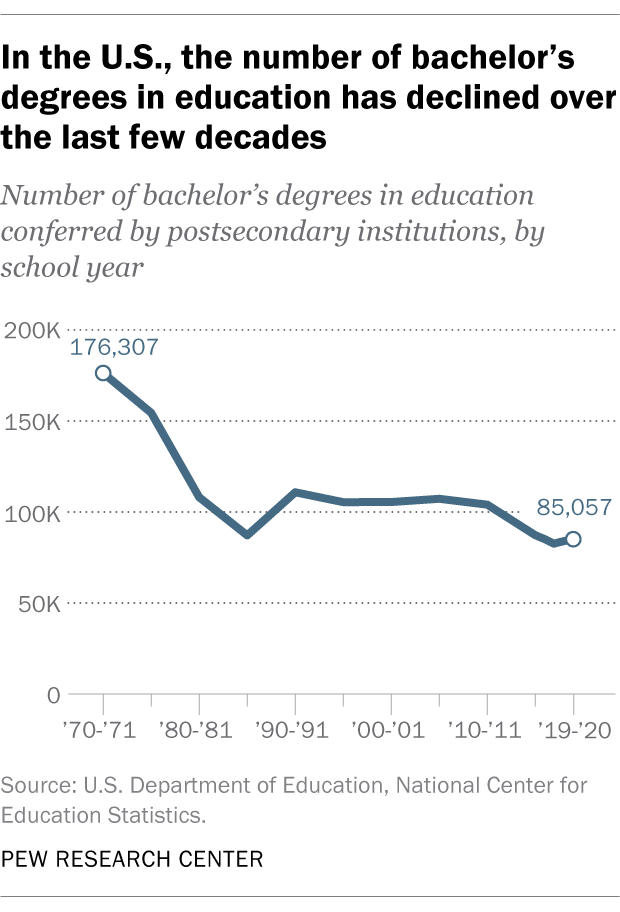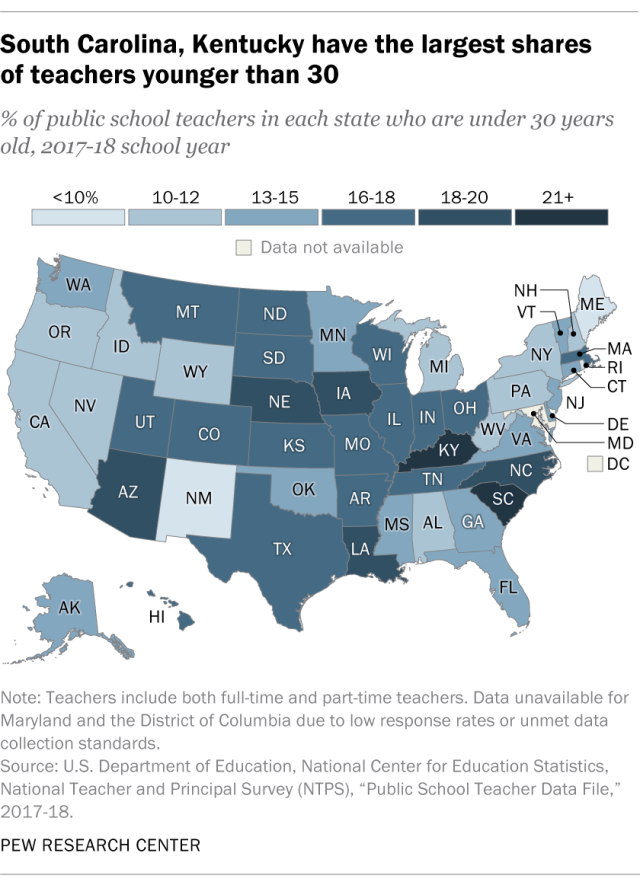The coronavirus pandemic has brought a host of challenges for the nation’s K-12 schools, including widespread reports of teacher shortages as the new school year begins. But the problem of attracting people to the profession is not necessarily a new one. Even before the pandemic, there were signs of a “pipeline problem” among the nation’s educators.
Both the number and share of new college graduates with a bachelor’s degree in education have decreased over the last few decades, according to data from the National Center for Education Statistics (NCES). That has occurred even as the overall number and share of Americans with a college degree have increased.
To assess the decline in education bachelor’s degrees conferred over time and the differences in younger teachers’ experiences, this Pew Research Center analysis uses federal data to analyze changes in these groups.
The analysis draws on more than three decades of data from the Integrated Postsecondary Education Data System (IPEDS), and survey data from the National Center for Education Statistics (NCES) and the National Teacher and Principal Survey (NTPS), formerly called the Schools and Staffing Survey. The analysis of conferred education degrees over time draws from five decades of IPEDS degree conferral data from all postsecondary institutions, which include colleges, universities and occupational and vocational schools.
The analysis of U.S. teachers’ age distribution uses the most recent NTPS data available (the 2017-18 school year). Data was unavailable for Maryland and the District of Columbia due to low response rates or unmet data collection standards. NTPS data includes both full-time and part-time public school teachers.

In 2019-20, the most recent year with available data, colleges and universities conferred 85,057 bachelor’s degrees in education, about 4% of the more than 2 million total degrees issued that year. That was down 19% from 2000-01, when colleges and universities issued more than 105,000 bachelor’s degrees in education, or roughly 8% of all undergraduate degrees.
The decrease is even more pronounced when looking at the longer term. During the 1970-71 school year, education was the most popular field for U.S. undergraduates. Colleges and universities issued 176,307 bachelor’s degrees in education that year, or 21% of all degrees conferred.
Women, in particular, have become much less likely to choose education as their field of study. More than a third (36%) of all bachelor’s degrees conferred to women were in education in 1970-71. By 2019-20, just 6% of the undergraduate degrees awarded to women were in education.
Among both men and women, colleges and universities now issue far more degrees in business and health professions (and related programs) than in education. Business and health degrees accounted for the two largest shares of all bachelor’s degrees conferred in 2019-20 at 19% and 13% of the total, respectively.
While a considerable proportion of K-12 teachers have bachelor’s degrees in education, it is not always a requirement for the job as long as prospective teachers complete necessary training and certifications. In addition to the decline in college graduates receiving degrees in education, however, teacher preparation programs have seen a steep decline in enrollment in recent years. And 44% of U.S. adults say they’re not at all likely to encourage a young person to become a K-12 teacher, according to NORC at the University of Chicago.
Experts have raised several possibilities for why fewer people are expressing interest in the profession, including high levels of stress and burnout, low wages that have remained stagnant, and concern about the political and ideological arguments surrounding classroom curriculums.
With fewer college graduates obtaining degrees in education, younger teachers have declined as a share of the nation’s overall elementary and secondary school teaching workforce. In 2017-18, the most recent school year for which NCES has published data on this topic, 15% of all public and private school K-12 teachers were under 30, down slightly from 17% in the 1999-2000 school year.
During the same time frame, older educators’ share of the teaching force has grown. Teachers ages 60 and older made up about 7% of K-12 instructors in 2017-18 – more than double their share in 1999-2000, when they accounted for 3% of all teachers.

There are state-level differences in teacher age distribution – at least among public school educators. During the 2017-18 school year, 15% of all U.S. public school teachers were under the age of 30. In 28 states, they made up a larger share of teachers than the national average. The states with the largest share of teachers in their 20s were South Carolina (23%), Kentucky (21%), Louisiana, Arizona and North Carolina (all roughly 20%). Teachers under 30 were the smallest share of the workforce in New Mexico (7%), Rhode Island (9%), Maine (9%), Nevada and California (both about 10%). Maine, New Mexico and Alaska, on the other hand, are the states where public school teachers skew the oldest – teachers 55 and older make up about a quarter of educators in each state.
